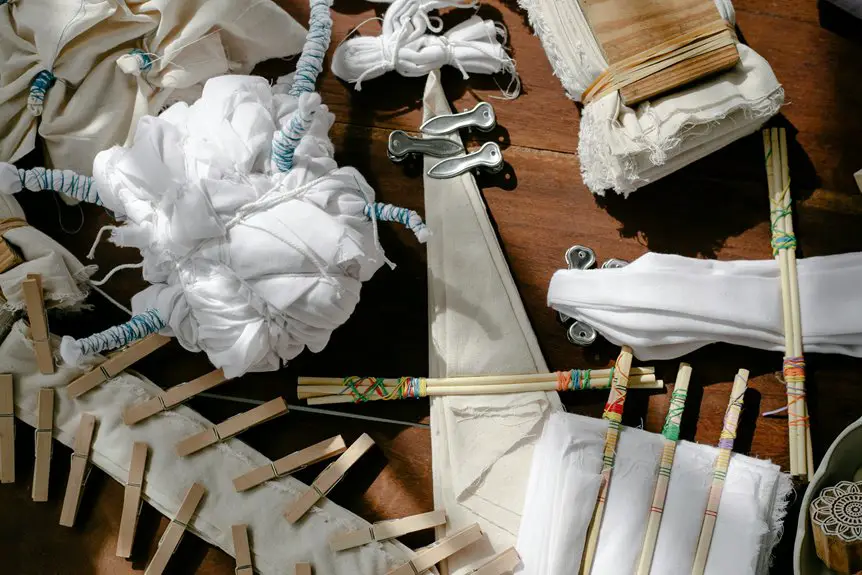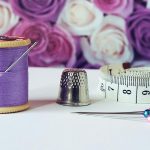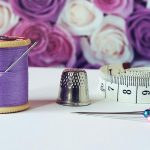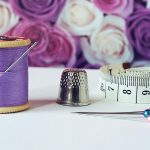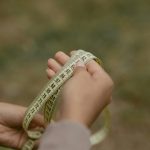To sew batik fabric, first pre-wash it gently in cold water to prevent color bleeding and remove excess dye. Use a sharp universal needle sized 70/10 or 90/14 based on the fabric’s weight, and opt for cotton or polyester thread that matches the fabric’s base color. Pin carefully with fine, sharp pins to avoid snagging, and mark with tailor’s chalk or water-soluble pens. Handle the fabric gently to preserve its patterns and texture. Keep going to discover more sewing and care tips for your batik projects.
Table of Contents
Key Takeaways
- Pre-wash batik fabric in cold water to remove excess dye and prevent color bleeding before sewing.
- Use a sharp universal needle sized 70/10 to 90/14 based on fabric weight to avoid snagging and puckering.
- Pin batik fabric with fine, sharp pins perpendicular to edges and mark with tailor’s chalk or water-soluble pen.
- Sew using high-quality cotton or polyester thread matching the fabric’s base color for strong, discreet stitches.
- Handle fabric gently, avoid harsh scrubbing, and air dry sewn projects away from direct sunlight to preserve colors.
Understanding Batik Fabric Characteristics
Batik fabric stands out because of its unique dyeing process, which creates vibrant patterns through wax resist techniques.
Batik fabric’s vibrant patterns are crafted through a distinctive wax resist dyeing process.
When you work with batik, you’ll notice it often has a slightly stiff texture due to the wax applied during dyeing. This stiffness affects how the fabric moves and sews, so you’ll want to handle it carefully to maintain the integrity of the patterns.
Batik is typically made from natural fibers like cotton or silk, which absorb dyes well but may shrink if not prewashed. The colors on batik fabrics are usually rich and multi-tonal, so avoid harsh washing or bleaching to preserve them.
Understanding these traits helps you prepare your fabric properly, ensuring your sewing project turns out beautifully.
Choosing the Right Sewing Needle
Since batik fabric has a slightly stiff texture and is often made from natural fibers like cotton or silk, picking the right sewing needle makes a big difference in your sewing experience.
You’ll want to use a sharp, universal needle sized between 70/10 and 90/14, depending on the fabric’s weight. For lighter batiks, a 70/10 needle works well, while heavier or tightly woven batik calls for a 90/14 needle to prevent skipped stitches or fabric damage.
Avoid ballpoint needles since they can snag the fabric’s fibers. Also, make sure your needle is fresh—dull needles may cause puckering or runs.
Changing your needle regularly keeps your stitching smooth and your batik looking flawless.
Selecting Appropriate Thread for Batik
When you choose the right thread, you guarantee your stitches hold strong without damaging the fabric. For batik, opt for high-quality cotton or polyester thread. Cotton thread matches batik’s natural fibers, offering strength and a smooth finish. Polyester thread adds durability and slight stretch, ideal for garments needing flexibility. Avoid thick or coarse threads that can puncture or distort the fabric.
Here’s a quick guide to help you select:
| Thread Type | Best Use |
|---|---|
| Cotton | Natural fiber batik, quilting |
| Polyester | Stretchy garments, durability |
| Silk | Luxury pieces, delicate seams |
| Nylon | Heavy-duty, outdoor items |
Pick a thread color close to your fabric’s base to keep stitches discreet and neat.
Pre-Washing and Preparing Batik Fabric
Choosing the right thread sets you up for success, but handling the fabric properly before sewing is just as important. Pre-washing your batik fabric removes excess dye and prevents colors from bleeding later.
Here’s how to prepare it:
- Soak the fabric in cold water for 15 minutes to loosen surface dye.
- Gently hand wash with mild detergent, avoiding harsh scrubbing.
- Rinse thoroughly until water runs clear to remove all soap and dye residue.
- Lay flat or hang to air dry, keeping it out of direct sunlight to preserve colors.
Taking these steps guarantees your batik fabric stays vibrant and stable, making your sewing process smoother and your final piece more durable.
Cutting Techniques for Batik Material
Precision is key as you cut your batik fabric to maintain its intricate patterns and vibrant colors. Use sharp, fabric scissors to avoid fraying edges and guarantee clean cuts. Always cut on a flat surface, aligning patterns carefully to keep designs continuous. Avoid stretching the fabric while cutting to preserve its shape.
| Technique | Tool Needed | Tip |
|---|---|---|
| Straight Cutting | Sharp scissors | Cut slowly along pattern lines |
| Curved Cutting | Rotary cutter | Use a ruler for smooth curves |
| Cutting Multiple Layers | Fabric shears | Pin layers securely to prevent shifting |
Tips for Pinning and Marking Batik Fabric
Although batik fabric’s intricate patterns demand careful handling, you can easily avoid damaging them by using the right pinning and marking techniques.
When working with batik, protect its design and texture by choosing gentle methods that don’t leave permanent marks or holes.
Here are four tips to keep your batik looking flawless:
- Use fine, sharp pins placed perpendicular to the fabric’s edge for minimal fabric distortion.
- Opt for silk pins or glass-head pins to avoid snagging the fabric.
- Mark your fabric with tailor’s chalk or a water-soluble pen, testing first on a scrap piece.
- Avoid using permanent markers or heavy chalk that might stain or alter the batik’s colors.
Following these steps helps preserve your fabric’s beauty while ensuring precise sewing.
Adjusting Sewing Machine Settings for Batik
When sewing batik fabric, start by choosing a sharp needle, like a universal or microtex, to prevent snags.
You’ll also want to lengthen your stitch slightly to avoid perforating the fabric. Adjusting these settings helps guarantee your stitches are clean and durable.
Needle Selection Tips
Choosing the right needle is essential for sewing batik fabric smoothly and preventing damage. Batik’s unique texture and tight weave call for a needle that can glide through without causing snags or holes.
Here are some needle selection tips to keep in mind:
- Use a universal needle size 70/10 or 80/12 for lightweight to medium-weight batik.
- Opt for a sharp or microtex needle to pierce the fabric cleanly and avoid fraying.
- Avoid ballpoint needles, as they can skip stitches on tightly woven batik.
- Change your needle regularly, ideally after every 6-8 hours of sewing, to maintain stitch quality.
Selecting the right needle supports smooth stitching and preserves your beautiful batik fabric.
Stitch Length Adjustment
Since batik fabric has a tight weave and delicate patterns, adjusting your stitch length is vital to achieve clean, even seams without damaging the material. Set your sewing machine to a slightly longer stitch length, around 2.5 to 3 millimeters. This prevents perforating the fabric too much, which can weaken the material or distort the design.
Short stitches tend to create too many needle holes, increasing the risk of fabric tearing or puckering. Before starting your project, test your stitch length on a fabric scrap to verify the tension and stitch quality look balanced. Adjust as needed to avoid bunching or loose stitches.
Stitching Techniques to Preserve Fabric Integrity
Although batik fabric is known for its delicate patterns and vibrant colors, you can maintain its beauty by using gentle stitching techniques that prevent damage. To preserve the fabric’s integrity, focus on careful handling and precise sewing methods.
Maintain batik’s vibrant beauty with gentle stitching and careful handling to preserve its delicate patterns.
- Use a fine needle (size 70/10 or 80/12) to avoid creating large holes in the fabric.
- Opt for a straight stitch with a moderate length to prevent puckering and stress on the fibers.
- Always sew slowly and smoothly, letting the machine feed the fabric evenly without pulling.
- Reinforce seams with French seams or flat-felled seams to protect edges and reduce fraying.
Care and Maintenance of Finished Batik Projects
To keep your finished batik projects looking vibrant, you’ll want to follow gentle washing instructions like hand washing in cold water.
Always avoid harsh detergents and direct sunlight when drying to preserve the colors.
When storing, fold your batik fabric carefully and keep it in a cool, dry place to prevent damage.
Washing Instructions
When you care for your finished batik projects properly, their vibrant colors and intricate patterns will last much longer. Washing batik fabric gently preserves its beauty and prevents fading.
Follow these steps to keep your batik looking fresh:
- Hand wash in cold water with a mild detergent to avoid harsh chemicals.
- Rinse thoroughly but gently to remove all soap without scrubbing.
- Avoid wringing; instead, press the fabric lightly to remove excess water.
- Dry in the shade on a flat surface to prevent direct sunlight from dulling colors.
Storage Tips
Since batik fabric is delicate and prone to fading, you’ll want to store your finished projects carefully to maintain their vibrant colors and intricate designs.
Keep them in a cool, dry place away from direct sunlight, which can cause the colors to fade quickly. Avoid plastic bags or airtight containers that trap moisture, leading to mildew or fabric damage.
Instead, use breathable cotton bags or wrap your pieces in acid-free tissue paper. If you fold your batik items, place tissue paper between folds to prevent creases and fabric wear.
Regularly check your stored projects for any signs of moisture or pests.
Frequently Asked Questions
Can Batik Fabric Be Used for Upholstery Projects?
You can use batik fabric for upholstery, but keep in mind it’s often lightweight and delicate. You’ll want to reinforce it or use it on low-traffic pieces to keep the vibrant patterns looking great longer.
How Do I Remove Wax Stains From Batik Fabric?
To remove wax stains from batik fabric, gently scrape off excess wax, place a paper towel over the stain, then iron on low heat to melt wax onto the towel. Finally, wash the fabric as usual.
Is Batik Fabric Suitable for Children’s Clothing?
Imagine dressing your child in a vibrant garden; batik fabric is just that—colorful and breathable. You’ll find it suitable for kids, but watch for delicate washing to keep those patterns bright and the fabric soft.
Where Can I Buy Authentic Batik Fabric?
You can buy authentic batik fabric from specialty stores, online marketplaces like Etsy, or directly from artisans in Indonesia. Look for sellers with good reviews to guarantee the fabric’s quality and authenticity.
Can Batik Fabric Be Dyed Again After Sewing?
You generally can’t dye batik fabric again after sewing because the wax resist blocks color absorption. If you try, colors might not adhere evenly, and the design could get damaged. It’s best to dye before sewing.
- Does Chiffon Fabric Stink - July 15, 2025
- Does Chiffon Fabric Affect the Economy - July 15, 2025
- Does Cotton Fabric Have a Nap - July 15, 2025

